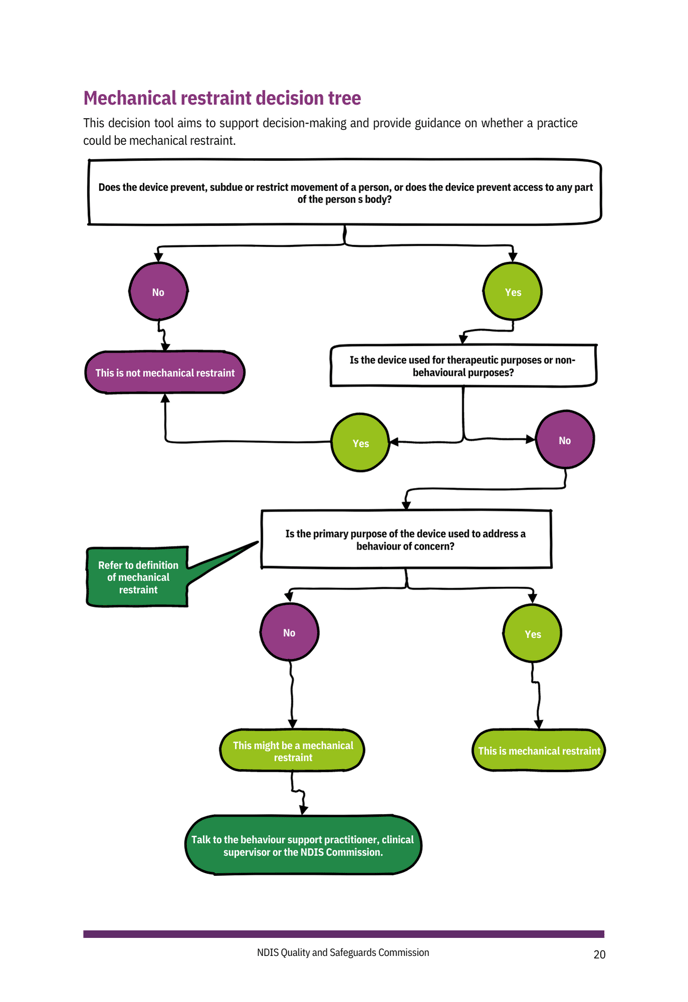As a platform, Like Family does not engage in restrictive practices of any kind. Social Carers must be able to identify what restrictive practice is and what it looks like in order to know how to avoid it
Restrictive practice is any practice or intervention that has the effect of restricting the rights or freedom of movement of a person with disability. There are five types of restrictive practice that are subject to oversight by the NDIS Commission:
- Mechanical
- Environmental
- Seclusion
- Chemical
- Physical
The use of restrictive practice for people with disability can potentially involve serious human rights breaches and requires considered oversight and continuous monitoring and adjustment by appropriately trained professionals. As such, the use of restrictive practice is strictly prohibited on the Like Family platform.
Mechanical Restraint
Mechanical restraint is the use of devices to limit someone's movement or control their behaviour. Examples of mechanical restraint include:
- Clothing that limits someone's movement and that the person cannot remove
- Velcro straps and belts
- Seatbelt locks
- Engaging a person's wheelchair brakes so they can't move if they want to
Environmental Restraint
Environmental restraint refers to when a person is denied access to a room or a part of their home. It can be referred to as "environmental control" or "environmental restraint". Examples of environmental restraint include:
- Locked cupboards, doors, or fridges to prevent a person from access
- Preventing or placing restrictions on a person engaging in activities (such as cooking or watching TV)
- Preventing access to personal possessions such as phones
- Preventing access to their environments such as a kitchen or backyard
- Restrictive access to the community (such as deeming the person must be supervised in order to go out)
- Restrictive access to hazardous items, sharps, and chemicals

Seclusion
Seclusion is the sole confinement of a person in a room or a physical space at any time where their voluntary exit is prevented, or not facilitated, or it is implied that voluntary exit is not permitted. Examples of seclusion include:
- Time out in a room or area where the person is unable to leave
- A person alone in a room or physical space with a barrier (including half doors) where they cannot leave
- A person is sent to their room to calm down and told they cannot come out until they have calmed down. This is seclusion if the person believes they cannot leave the room until they are calm
- Staff and other residents retreating to an office, secure room, or backyard while the person is restricted to the remainder of the house and is unable to leave, or believes they are unable to leave.

Chemical Restraint
Chemical restraint refers to the use of medication for the primary purpose of influencing a person's behaviour or movement. Examples of chemical restraint include:
- Use of psychotropic medications when behaviours may not be occurring
- Over-medication or misuse of medication
- Long-term use of medication without a review to reduce the use of medication for the purposes of behaviour management
- Menstruation suppression

Physical Restraint
Physical restraint is the use or action of physical force to prevent, restrict or subdue movement of a person's body, or part of their body for the primary purpose of influencing their behaviour. Physical restraint is perhaps the most easily identifiable form of restrictive practice. It is also the most dangerous. Examples of physical restraint include:
- Holding down a person's hand to prevent them from hitting themselves
- Holding down any part of the body to restrict movement
- Taking the person's hand and pulling them in a direction they don't want to go

What if I have been involved in or suspect I am being asked to provide restrictive practice as a Social Carer?
If you have engaged in restrictive practice, or suspect that the support you have been asked to provide could be restrictive practice, you must notify Like Family immediately by calling us on 1800-545-332 or emailing hello@likefamily.com.au.
This information has been provided courtesy of the NDIS Quality and Safeguards Commission's Regulated Restrictive Practices Guide.
-2.png?height=120&name=LikeFamily_logo_RED%20(2)-2.png)
